Holmes Institute HI6025 Accounting for Lease: AASB 16 Critical Review
VerifiedAdded on 2022/11/24
|17
|4701
|456
Report
AI Summary
This report critically evaluates the new Australian Accounting Standard for Lease (AASB 16), contrasting it with the previous standard (AASB 117). It highlights the drawbacks of AASB 117, such as issues in asset recognition and financial representation, which AASB 16 addresses by eliminating the classification of leases into finance and operating leases. The report examines the need for change, the specific changes incorporated in AASB 16, and the impact of these changes on companies with significant lease financing. It also explores the shift towards classifying leases as operating leases and its relation to managerial behavior, the improvements in comparability offered by IFRS 16, and potential effects on companies' asset purchasing decisions. The report includes a summary of key disclosures made by a specified company regarding their accounting for leases, including transitional provisions and the impact of transitioning from AASB 117 to AASB 16.
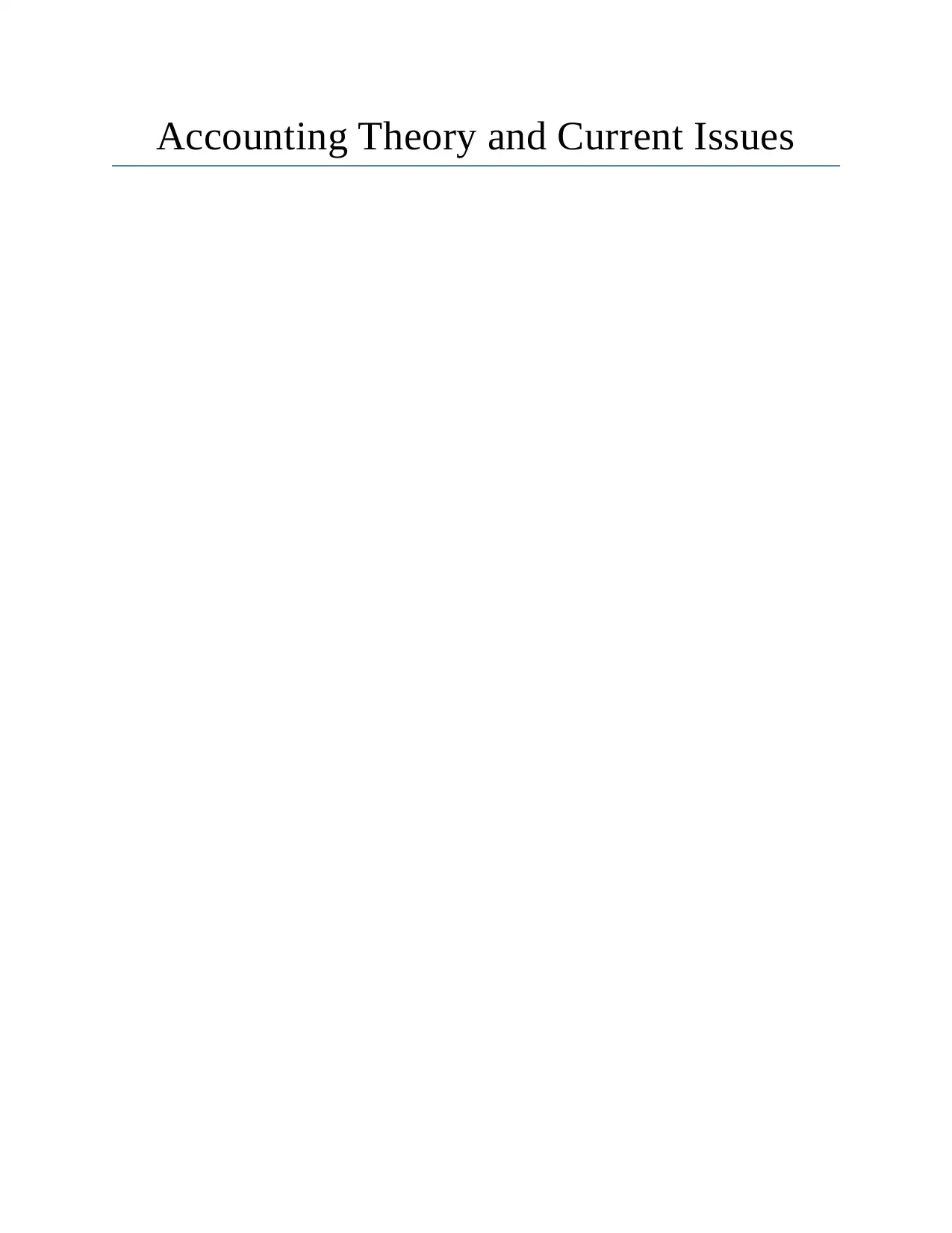
Accounting Theory and Current Issues
Paraphrase This Document
Need a fresh take? Get an instant paraphrase of this document with our AI Paraphraser
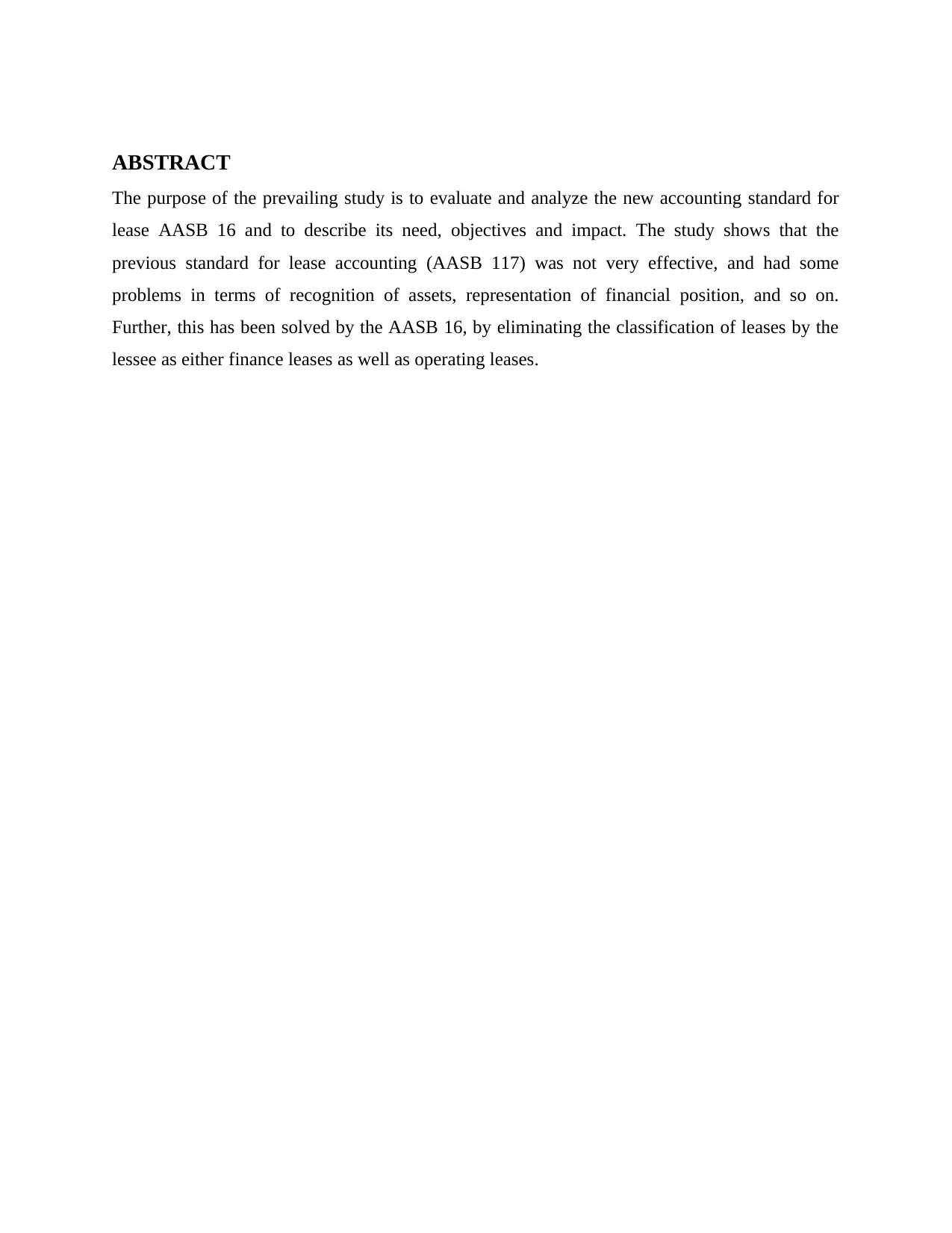
ABSTRACT
The purpose of the prevailing study is to evaluate and analyze the new accounting standard for
lease AASB 16 and to describe its need, objectives and impact. The study shows that the
previous standard for lease accounting (AASB 117) was not very effective, and had some
problems in terms of recognition of assets, representation of financial position, and so on.
Further, this has been solved by the AASB 16, by eliminating the classification of leases by the
lessee as either finance leases as well as operating leases.
The purpose of the prevailing study is to evaluate and analyze the new accounting standard for
lease AASB 16 and to describe its need, objectives and impact. The study shows that the
previous standard for lease accounting (AASB 117) was not very effective, and had some
problems in terms of recognition of assets, representation of financial position, and so on.
Further, this has been solved by the AASB 16, by eliminating the classification of leases by the
lessee as either finance leases as well as operating leases.
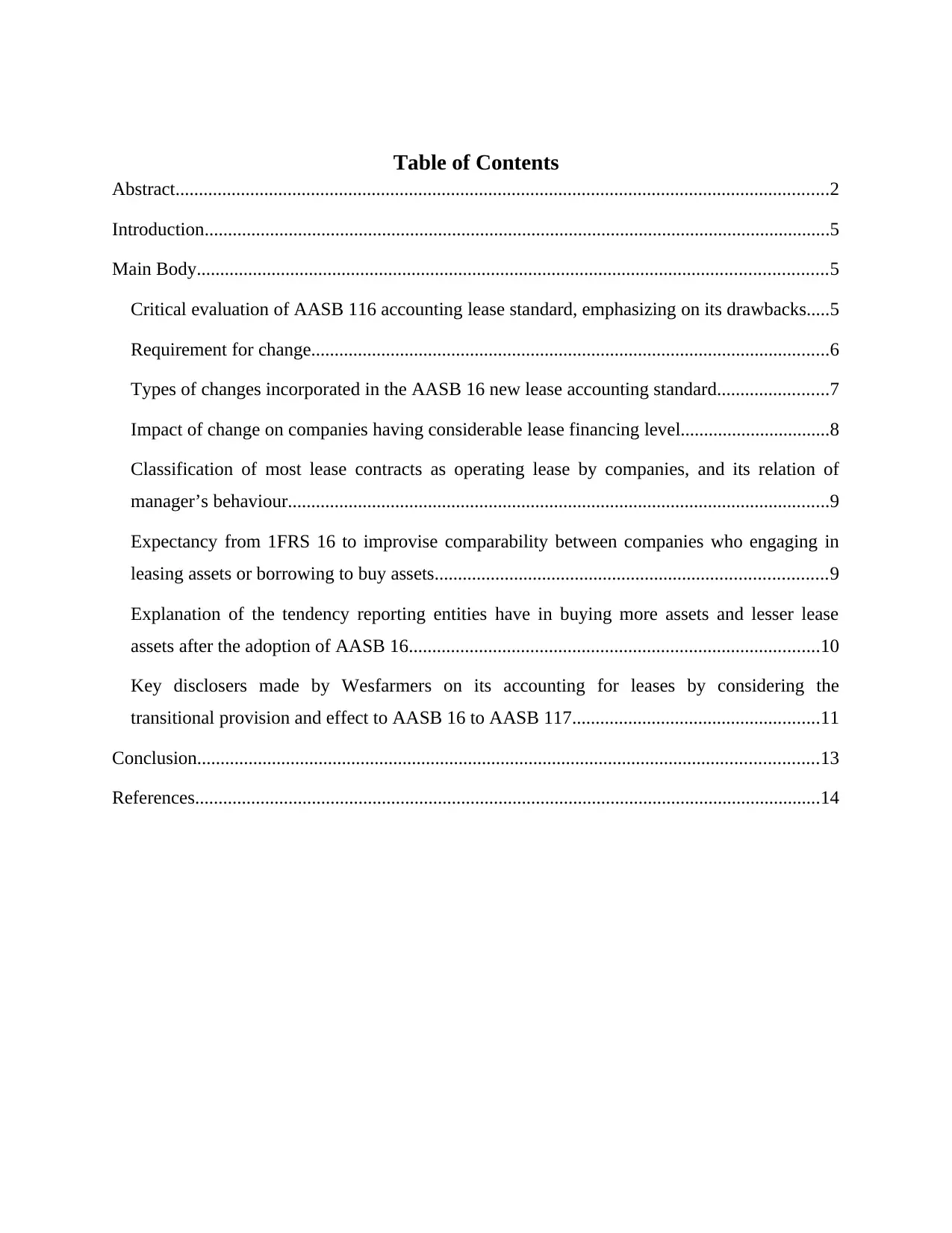
Table of Contents
Abstract............................................................................................................................................2
Introduction......................................................................................................................................5
Main Body.......................................................................................................................................5
Critical evaluation of AASB 116 accounting lease standard, emphasizing on its drawbacks.....5
Requirement for change...............................................................................................................6
Types of changes incorporated in the AASB 16 new lease accounting standard........................7
Impact of change on companies having considerable lease financing level................................8
Classification of most lease contracts as operating lease by companies, and its relation of
manager’s behaviour....................................................................................................................9
Expectancy from 1FRS 16 to improvise comparability between companies who engaging in
leasing assets or borrowing to buy assets....................................................................................9
Explanation of the tendency reporting entities have in buying more assets and lesser lease
assets after the adoption of AASB 16........................................................................................10
Key disclosers made by Wesfarmers on its accounting for leases by considering the
transitional provision and effect to AASB 16 to AASB 117.....................................................11
Conclusion.....................................................................................................................................13
References......................................................................................................................................14
Abstract............................................................................................................................................2
Introduction......................................................................................................................................5
Main Body.......................................................................................................................................5
Critical evaluation of AASB 116 accounting lease standard, emphasizing on its drawbacks.....5
Requirement for change...............................................................................................................6
Types of changes incorporated in the AASB 16 new lease accounting standard........................7
Impact of change on companies having considerable lease financing level................................8
Classification of most lease contracts as operating lease by companies, and its relation of
manager’s behaviour....................................................................................................................9
Expectancy from 1FRS 16 to improvise comparability between companies who engaging in
leasing assets or borrowing to buy assets....................................................................................9
Explanation of the tendency reporting entities have in buying more assets and lesser lease
assets after the adoption of AASB 16........................................................................................10
Key disclosers made by Wesfarmers on its accounting for leases by considering the
transitional provision and effect to AASB 16 to AASB 117.....................................................11
Conclusion.....................................................................................................................................13
References......................................................................................................................................14
⊘ This is a preview!⊘
Do you want full access?
Subscribe today to unlock all pages.

Trusted by 1+ million students worldwide
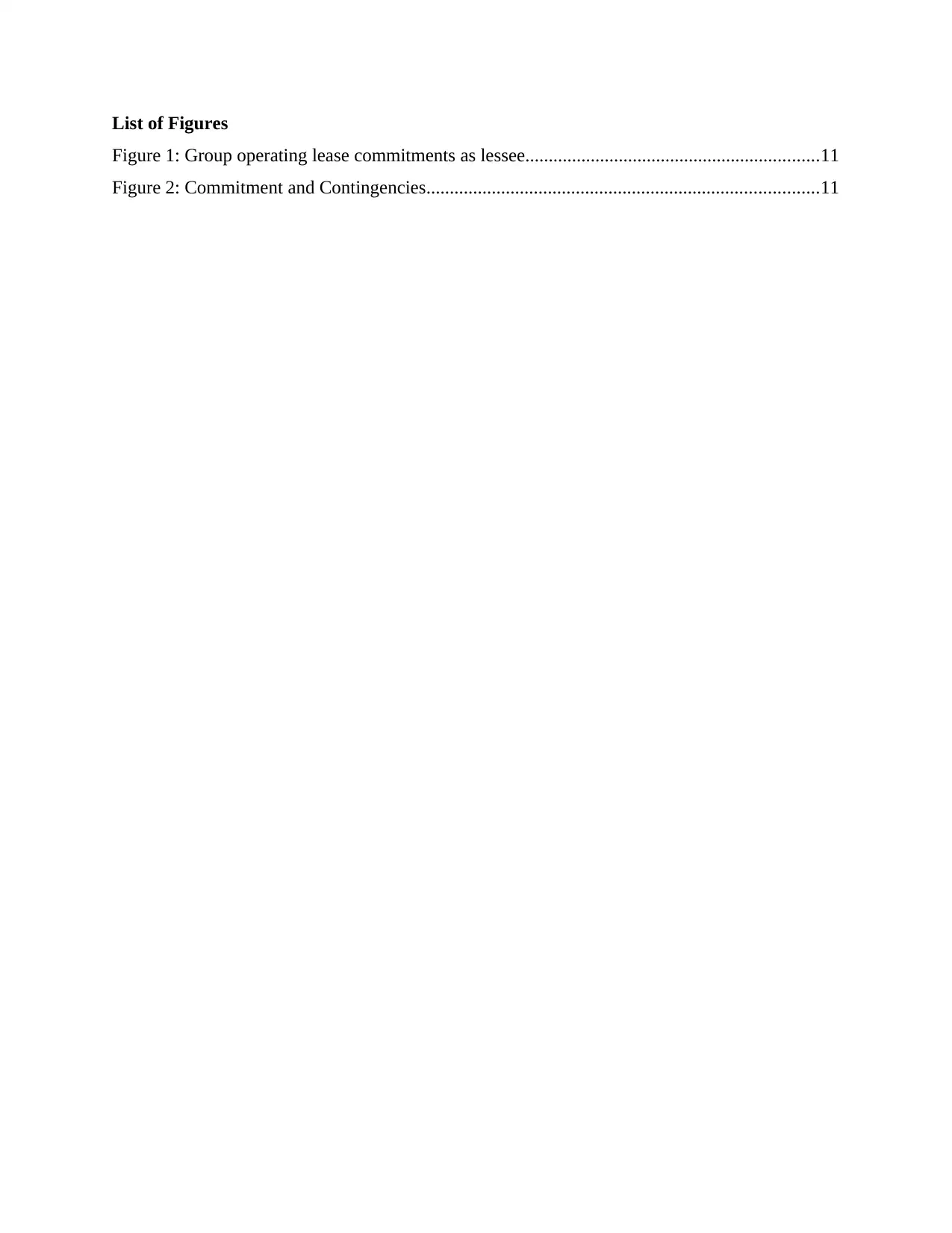
List of Figures
Figure 1: Group operating lease commitments as lessee...............................................................11
Figure 2: Commitment and Contingencies....................................................................................11
Figure 1: Group operating lease commitments as lessee...............................................................11
Figure 2: Commitment and Contingencies....................................................................................11
Paraphrase This Document
Need a fresh take? Get an instant paraphrase of this document with our AI Paraphraser
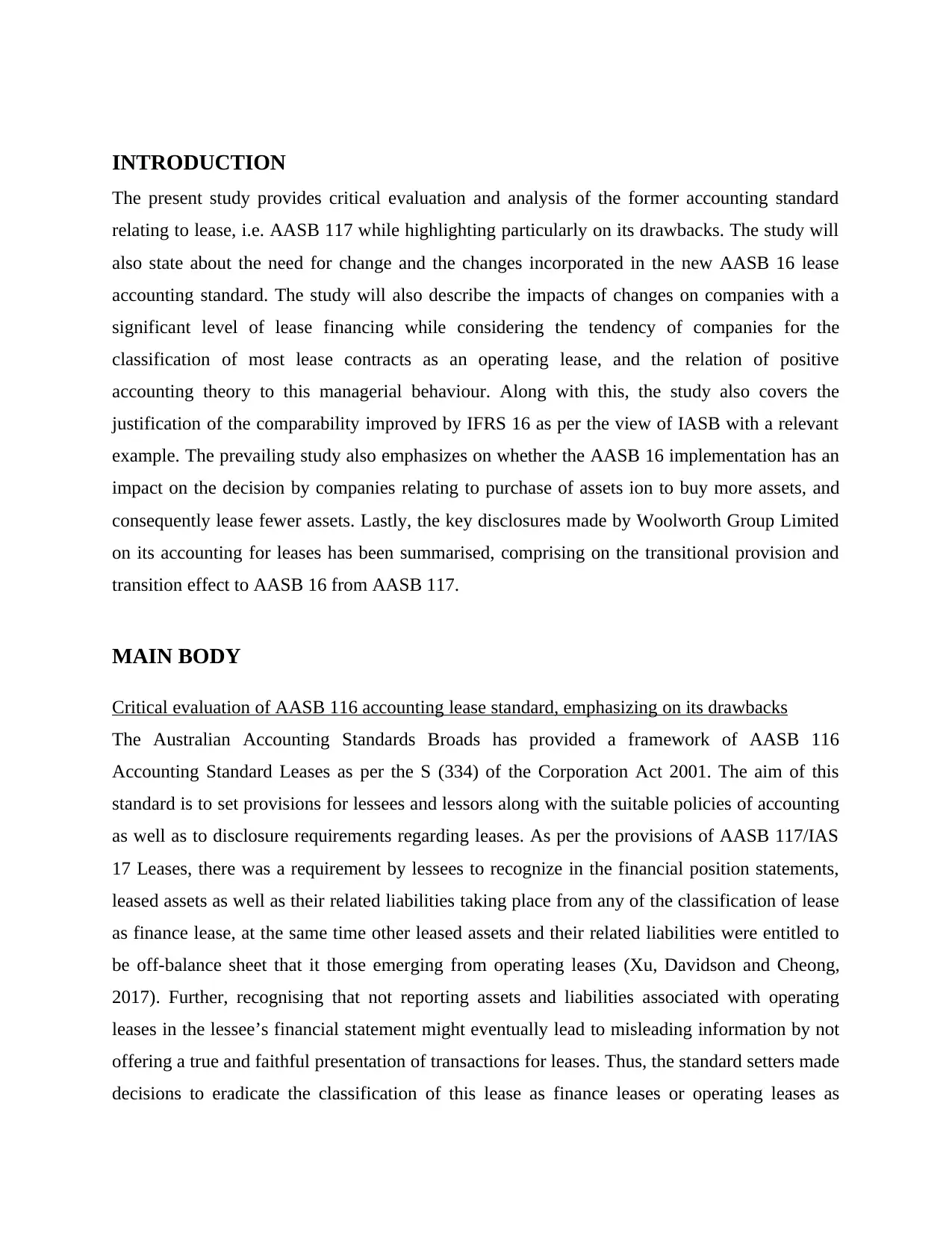
INTRODUCTION
The present study provides critical evaluation and analysis of the former accounting standard
relating to lease, i.e. AASB 117 while highlighting particularly on its drawbacks. The study will
also state about the need for change and the changes incorporated in the new AASB 16 lease
accounting standard. The study will also describe the impacts of changes on companies with a
significant level of lease financing while considering the tendency of companies for the
classification of most lease contracts as an operating lease, and the relation of positive
accounting theory to this managerial behaviour. Along with this, the study also covers the
justification of the comparability improved by IFRS 16 as per the view of IASB with a relevant
example. The prevailing study also emphasizes on whether the AASB 16 implementation has an
impact on the decision by companies relating to purchase of assets ion to buy more assets, and
consequently lease fewer assets. Lastly, the key disclosures made by Woolworth Group Limited
on its accounting for leases has been summarised, comprising on the transitional provision and
transition effect to AASB 16 from AASB 117.
MAIN BODY
Critical evaluation of AASB 116 accounting lease standard, emphasizing on its drawbacks
The Australian Accounting Standards Broads has provided a framework of AASB 116
Accounting Standard Leases as per the S (334) of the Corporation Act 2001. The aim of this
standard is to set provisions for lessees and lessors along with the suitable policies of accounting
as well as to disclosure requirements regarding leases. As per the provisions of AASB 117/IAS
17 Leases, there was a requirement by lessees to recognize in the financial position statements,
leased assets as well as their related liabilities taking place from any of the classification of lease
as finance lease, at the same time other leased assets and their related liabilities were entitled to
be off-balance sheet that it those emerging from operating leases (Xu, Davidson and Cheong,
2017). Further, recognising that not reporting assets and liabilities associated with operating
leases in the lessee’s financial statement might eventually lead to misleading information by not
offering a true and faithful presentation of transactions for leases. Thus, the standard setters made
decisions to eradicate the classification of this lease as finance leases or operating leases as
The present study provides critical evaluation and analysis of the former accounting standard
relating to lease, i.e. AASB 117 while highlighting particularly on its drawbacks. The study will
also state about the need for change and the changes incorporated in the new AASB 16 lease
accounting standard. The study will also describe the impacts of changes on companies with a
significant level of lease financing while considering the tendency of companies for the
classification of most lease contracts as an operating lease, and the relation of positive
accounting theory to this managerial behaviour. Along with this, the study also covers the
justification of the comparability improved by IFRS 16 as per the view of IASB with a relevant
example. The prevailing study also emphasizes on whether the AASB 16 implementation has an
impact on the decision by companies relating to purchase of assets ion to buy more assets, and
consequently lease fewer assets. Lastly, the key disclosures made by Woolworth Group Limited
on its accounting for leases has been summarised, comprising on the transitional provision and
transition effect to AASB 16 from AASB 117.
MAIN BODY
Critical evaluation of AASB 116 accounting lease standard, emphasizing on its drawbacks
The Australian Accounting Standards Broads has provided a framework of AASB 116
Accounting Standard Leases as per the S (334) of the Corporation Act 2001. The aim of this
standard is to set provisions for lessees and lessors along with the suitable policies of accounting
as well as to disclosure requirements regarding leases. As per the provisions of AASB 117/IAS
17 Leases, there was a requirement by lessees to recognize in the financial position statements,
leased assets as well as their related liabilities taking place from any of the classification of lease
as finance lease, at the same time other leased assets and their related liabilities were entitled to
be off-balance sheet that it those emerging from operating leases (Xu, Davidson and Cheong,
2017). Further, recognising that not reporting assets and liabilities associated with operating
leases in the lessee’s financial statement might eventually lead to misleading information by not
offering a true and faithful presentation of transactions for leases. Thus, the standard setters made
decisions to eradicate the classification of this lease as finance leases or operating leases as
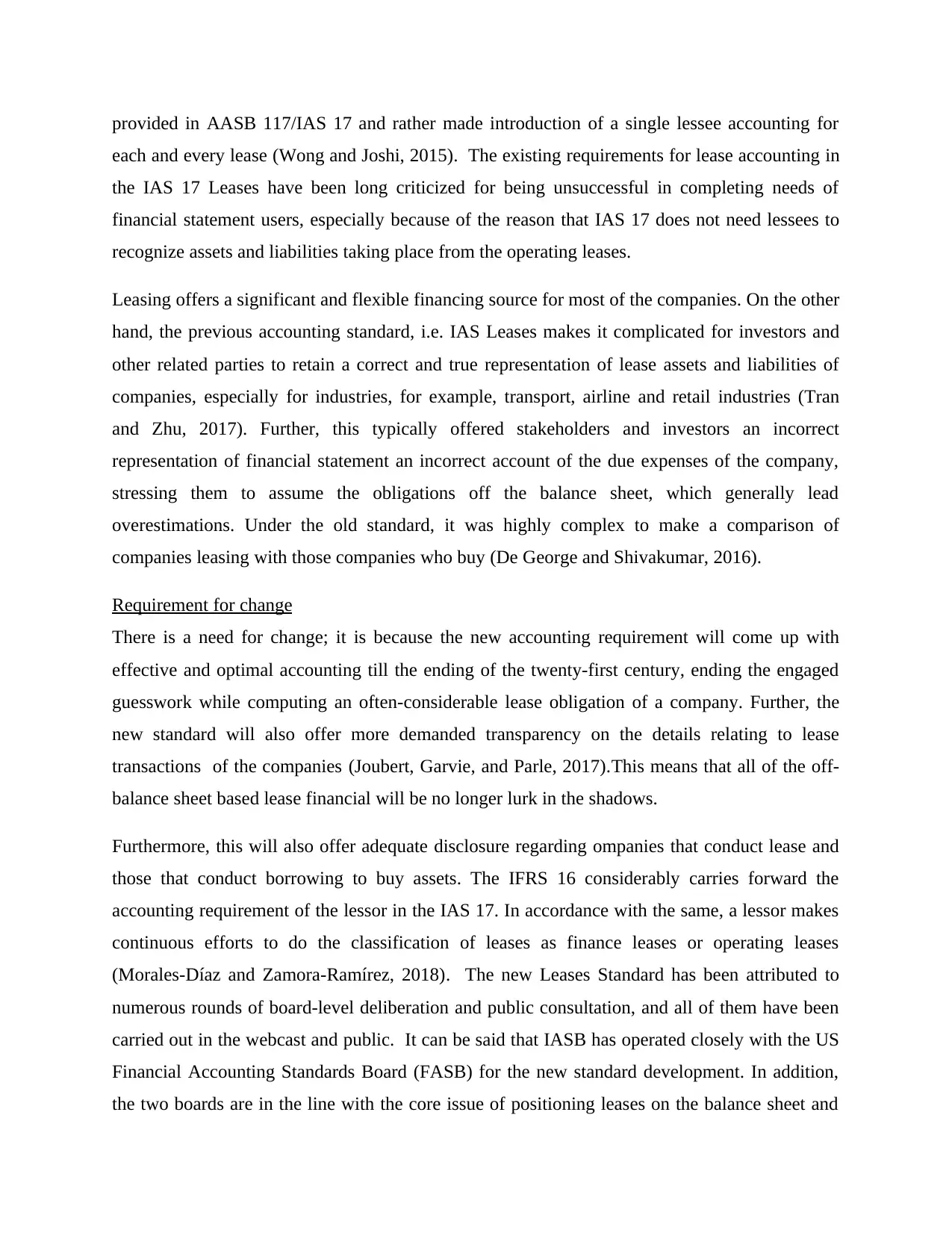
provided in AASB 117/IAS 17 and rather made introduction of a single lessee accounting for
each and every lease (Wong and Joshi, 2015). The existing requirements for lease accounting in
the IAS 17 Leases have been long criticized for being unsuccessful in completing needs of
financial statement users, especially because of the reason that IAS 17 does not need lessees to
recognize assets and liabilities taking place from the operating leases.
Leasing offers a significant and flexible financing source for most of the companies. On the other
hand, the previous accounting standard, i.e. IAS Leases makes it complicated for investors and
other related parties to retain a correct and true representation of lease assets and liabilities of
companies, especially for industries, for example, transport, airline and retail industries (Tran
and Zhu, 2017). Further, this typically offered stakeholders and investors an incorrect
representation of financial statement an incorrect account of the due expenses of the company,
stressing them to assume the obligations off the balance sheet, which generally lead
overestimations. Under the old standard, it was highly complex to make a comparison of
companies leasing with those companies who buy (De George and Shivakumar, 2016).
Requirement for change
There is a need for change; it is because the new accounting requirement will come up with
effective and optimal accounting till the ending of the twenty-first century, ending the engaged
guesswork while computing an often-considerable lease obligation of a company. Further, the
new standard will also offer more demanded transparency on the details relating to lease
transactions of the companies (Joubert, Garvie, and Parle, 2017).This means that all of the off-
balance sheet based lease financial will be no longer lurk in the shadows.
Furthermore, this will also offer adequate disclosure regarding ompanies that conduct lease and
those that conduct borrowing to buy assets. The IFRS 16 considerably carries forward the
accounting requirement of the lessor in the IAS 17. In accordance with the same, a lessor makes
continuous efforts to do the classification of leases as finance leases or operating leases
(Morales-Díaz and Zamora-Ramírez, 2018). The new Leases Standard has been attributed to
numerous rounds of board-level deliberation and public consultation, and all of them have been
carried out in the webcast and public. It can be said that IASB has operated closely with the US
Financial Accounting Standards Board (FASB) for the new standard development. In addition,
the two boards are in the line with the core issue of positioning leases on the balance sheet and
each and every lease (Wong and Joshi, 2015). The existing requirements for lease accounting in
the IAS 17 Leases have been long criticized for being unsuccessful in completing needs of
financial statement users, especially because of the reason that IAS 17 does not need lessees to
recognize assets and liabilities taking place from the operating leases.
Leasing offers a significant and flexible financing source for most of the companies. On the other
hand, the previous accounting standard, i.e. IAS Leases makes it complicated for investors and
other related parties to retain a correct and true representation of lease assets and liabilities of
companies, especially for industries, for example, transport, airline and retail industries (Tran
and Zhu, 2017). Further, this typically offered stakeholders and investors an incorrect
representation of financial statement an incorrect account of the due expenses of the company,
stressing them to assume the obligations off the balance sheet, which generally lead
overestimations. Under the old standard, it was highly complex to make a comparison of
companies leasing with those companies who buy (De George and Shivakumar, 2016).
Requirement for change
There is a need for change; it is because the new accounting requirement will come up with
effective and optimal accounting till the ending of the twenty-first century, ending the engaged
guesswork while computing an often-considerable lease obligation of a company. Further, the
new standard will also offer more demanded transparency on the details relating to lease
transactions of the companies (Joubert, Garvie, and Parle, 2017).This means that all of the off-
balance sheet based lease financial will be no longer lurk in the shadows.
Furthermore, this will also offer adequate disclosure regarding ompanies that conduct lease and
those that conduct borrowing to buy assets. The IFRS 16 considerably carries forward the
accounting requirement of the lessor in the IAS 17. In accordance with the same, a lessor makes
continuous efforts to do the classification of leases as finance leases or operating leases
(Morales-Díaz and Zamora-Ramírez, 2018). The new Leases Standard has been attributed to
numerous rounds of board-level deliberation and public consultation, and all of them have been
carried out in the webcast and public. It can be said that IASB has operated closely with the US
Financial Accounting Standards Board (FASB) for the new standard development. In addition,
the two boards are in the line with the core issue of positioning leases on the balance sheet and
⊘ This is a preview!⊘
Do you want full access?
Subscribe today to unlock all pages.

Trusted by 1+ million students worldwide
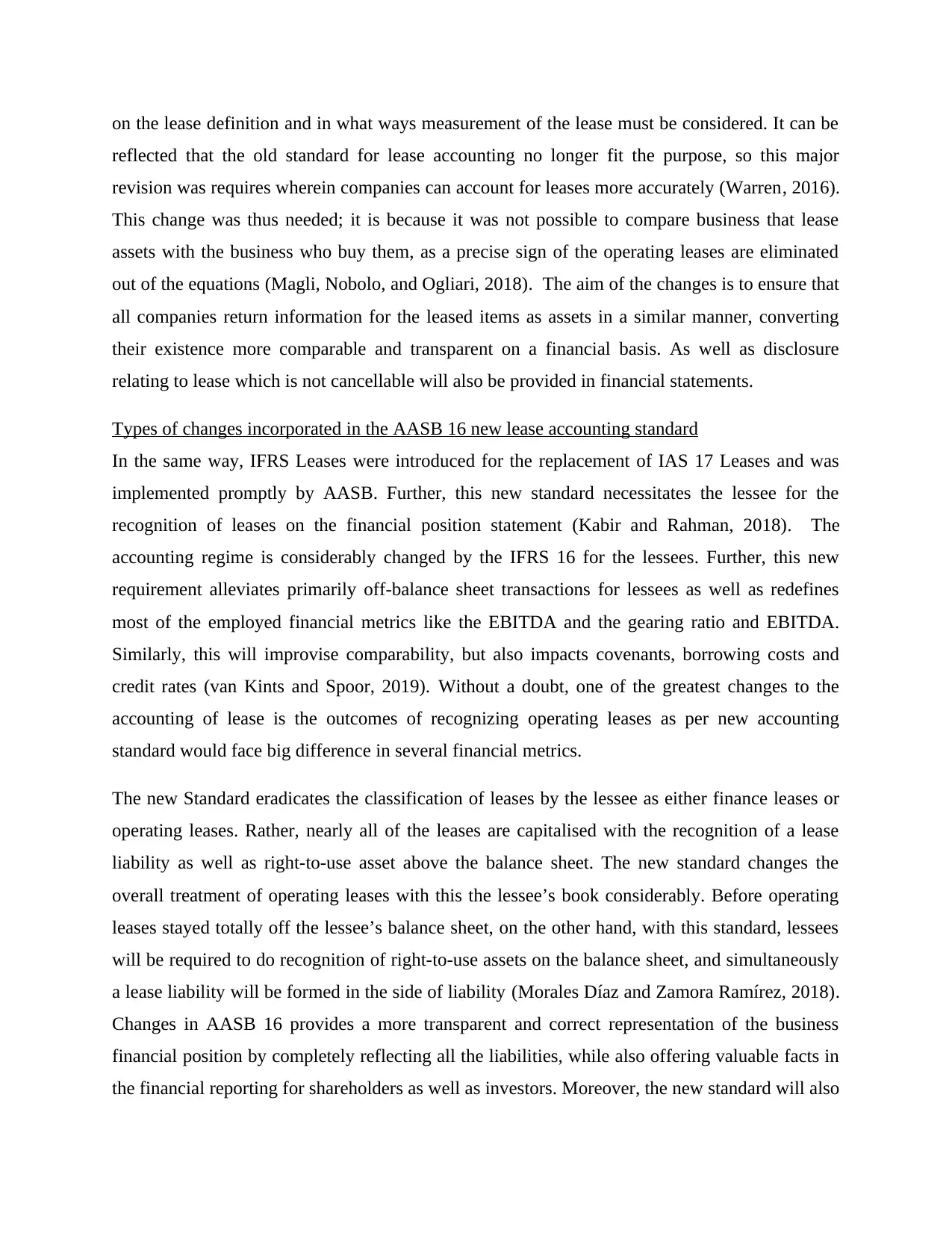
on the lease definition and in what ways measurement of the lease must be considered. It can be
reflected that the old standard for lease accounting no longer fit the purpose, so this major
revision was requires wherein companies can account for leases more accurately (Warren, 2016).
This change was thus needed; it is because it was not possible to compare business that lease
assets with the business who buy them, as a precise sign of the operating leases are eliminated
out of the equations (Magli, Nobolo, and Ogliari, 2018). The aim of the changes is to ensure that
all companies return information for the leased items as assets in a similar manner, converting
their existence more comparable and transparent on a financial basis. As well as disclosure
relating to lease which is not cancellable will also be provided in financial statements.
Types of changes incorporated in the AASB 16 new lease accounting standard
In the same way, IFRS Leases were introduced for the replacement of IAS 17 Leases and was
implemented promptly by AASB. Further, this new standard necessitates the lessee for the
recognition of leases on the financial position statement (Kabir and Rahman, 2018). The
accounting regime is considerably changed by the IFRS 16 for the lessees. Further, this new
requirement alleviates primarily off-balance sheet transactions for lessees as well as redefines
most of the employed financial metrics like the EBITDA and the gearing ratio and EBITDA.
Similarly, this will improvise comparability, but also impacts covenants, borrowing costs and
credit rates (van Kints and Spoor, 2019). Without a doubt, one of the greatest changes to the
accounting of lease is the outcomes of recognizing operating leases as per new accounting
standard would face big difference in several financial metrics.
The new Standard eradicates the classification of leases by the lessee as either finance leases or
operating leases. Rather, nearly all of the leases are capitalised with the recognition of a lease
liability as well as right-to-use asset above the balance sheet. The new standard changes the
overall treatment of operating leases with this the lessee’s book considerably. Before operating
leases stayed totally off the lessee’s balance sheet, on the other hand, with this standard, lessees
will be required to do recognition of right-to-use assets on the balance sheet, and simultaneously
a lease liability will be formed in the side of liability (Morales Díaz and Zamora Ramírez, 2018).
Changes in AASB 16 provides a more transparent and correct representation of the business
financial position by completely reflecting all the liabilities, while also offering valuable facts in
the financial reporting for shareholders as well as investors. Moreover, the new standard will also
reflected that the old standard for lease accounting no longer fit the purpose, so this major
revision was requires wherein companies can account for leases more accurately (Warren, 2016).
This change was thus needed; it is because it was not possible to compare business that lease
assets with the business who buy them, as a precise sign of the operating leases are eliminated
out of the equations (Magli, Nobolo, and Ogliari, 2018). The aim of the changes is to ensure that
all companies return information for the leased items as assets in a similar manner, converting
their existence more comparable and transparent on a financial basis. As well as disclosure
relating to lease which is not cancellable will also be provided in financial statements.
Types of changes incorporated in the AASB 16 new lease accounting standard
In the same way, IFRS Leases were introduced for the replacement of IAS 17 Leases and was
implemented promptly by AASB. Further, this new standard necessitates the lessee for the
recognition of leases on the financial position statement (Kabir and Rahman, 2018). The
accounting regime is considerably changed by the IFRS 16 for the lessees. Further, this new
requirement alleviates primarily off-balance sheet transactions for lessees as well as redefines
most of the employed financial metrics like the EBITDA and the gearing ratio and EBITDA.
Similarly, this will improvise comparability, but also impacts covenants, borrowing costs and
credit rates (van Kints and Spoor, 2019). Without a doubt, one of the greatest changes to the
accounting of lease is the outcomes of recognizing operating leases as per new accounting
standard would face big difference in several financial metrics.
The new Standard eradicates the classification of leases by the lessee as either finance leases or
operating leases. Rather, nearly all of the leases are capitalised with the recognition of a lease
liability as well as right-to-use asset above the balance sheet. The new standard changes the
overall treatment of operating leases with this the lessee’s book considerably. Before operating
leases stayed totally off the lessee’s balance sheet, on the other hand, with this standard, lessees
will be required to do recognition of right-to-use assets on the balance sheet, and simultaneously
a lease liability will be formed in the side of liability (Morales Díaz and Zamora Ramírez, 2018).
Changes in AASB 16 provides a more transparent and correct representation of the business
financial position by completely reflecting all the liabilities, while also offering valuable facts in
the financial reporting for shareholders as well as investors. Moreover, the new standard will also
Paraphrase This Document
Need a fresh take? Get an instant paraphrase of this document with our AI Paraphraser
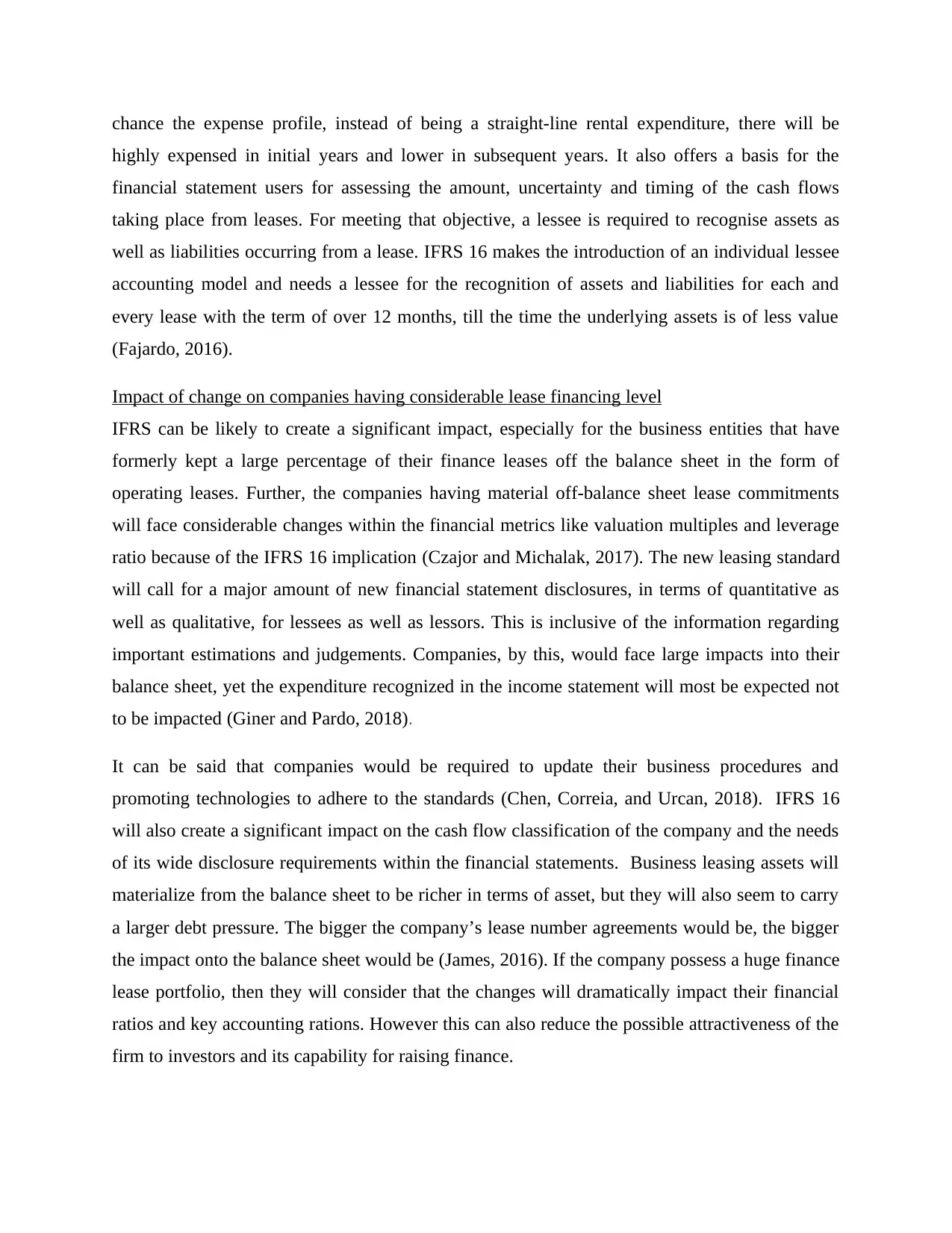
chance the expense profile, instead of being a straight-line rental expenditure, there will be
highly expensed in initial years and lower in subsequent years. It also offers a basis for the
financial statement users for assessing the amount, uncertainty and timing of the cash flows
taking place from leases. For meeting that objective, a lessee is required to recognise assets as
well as liabilities occurring from a lease. IFRS 16 makes the introduction of an individual lessee
accounting model and needs a lessee for the recognition of assets and liabilities for each and
every lease with the term of over 12 months, till the time the underlying assets is of less value
(Fajardo, 2016).
Impact of change on companies having considerable lease financing level
IFRS can be likely to create a significant impact, especially for the business entities that have
formerly kept a large percentage of their finance leases off the balance sheet in the form of
operating leases. Further, the companies having material off-balance sheet lease commitments
will face considerable changes within the financial metrics like valuation multiples and leverage
ratio because of the IFRS 16 implication (Czajor and Michalak, 2017). The new leasing standard
will call for a major amount of new financial statement disclosures, in terms of quantitative as
well as qualitative, for lessees as well as lessors. This is inclusive of the information regarding
important estimations and judgements. Companies, by this, would face large impacts into their
balance sheet, yet the expenditure recognized in the income statement will most be expected not
to be impacted (Giner and Pardo, 2018).
It can be said that companies would be required to update their business procedures and
promoting technologies to adhere to the standards (Chen, Correia, and Urcan, 2018). IFRS 16
will also create a significant impact on the cash flow classification of the company and the needs
of its wide disclosure requirements within the financial statements. Business leasing assets will
materialize from the balance sheet to be richer in terms of asset, but they will also seem to carry
a larger debt pressure. The bigger the company’s lease number agreements would be, the bigger
the impact onto the balance sheet would be (James, 2016). If the company possess a huge finance
lease portfolio, then they will consider that the changes will dramatically impact their financial
ratios and key accounting rations. However this can also reduce the possible attractiveness of the
firm to investors and its capability for raising finance.
highly expensed in initial years and lower in subsequent years. It also offers a basis for the
financial statement users for assessing the amount, uncertainty and timing of the cash flows
taking place from leases. For meeting that objective, a lessee is required to recognise assets as
well as liabilities occurring from a lease. IFRS 16 makes the introduction of an individual lessee
accounting model and needs a lessee for the recognition of assets and liabilities for each and
every lease with the term of over 12 months, till the time the underlying assets is of less value
(Fajardo, 2016).
Impact of change on companies having considerable lease financing level
IFRS can be likely to create a significant impact, especially for the business entities that have
formerly kept a large percentage of their finance leases off the balance sheet in the form of
operating leases. Further, the companies having material off-balance sheet lease commitments
will face considerable changes within the financial metrics like valuation multiples and leverage
ratio because of the IFRS 16 implication (Czajor and Michalak, 2017). The new leasing standard
will call for a major amount of new financial statement disclosures, in terms of quantitative as
well as qualitative, for lessees as well as lessors. This is inclusive of the information regarding
important estimations and judgements. Companies, by this, would face large impacts into their
balance sheet, yet the expenditure recognized in the income statement will most be expected not
to be impacted (Giner and Pardo, 2018).
It can be said that companies would be required to update their business procedures and
promoting technologies to adhere to the standards (Chen, Correia, and Urcan, 2018). IFRS 16
will also create a significant impact on the cash flow classification of the company and the needs
of its wide disclosure requirements within the financial statements. Business leasing assets will
materialize from the balance sheet to be richer in terms of asset, but they will also seem to carry
a larger debt pressure. The bigger the company’s lease number agreements would be, the bigger
the impact onto the balance sheet would be (James, 2016). If the company possess a huge finance
lease portfolio, then they will consider that the changes will dramatically impact their financial
ratios and key accounting rations. However this can also reduce the possible attractiveness of the
firm to investors and its capability for raising finance.
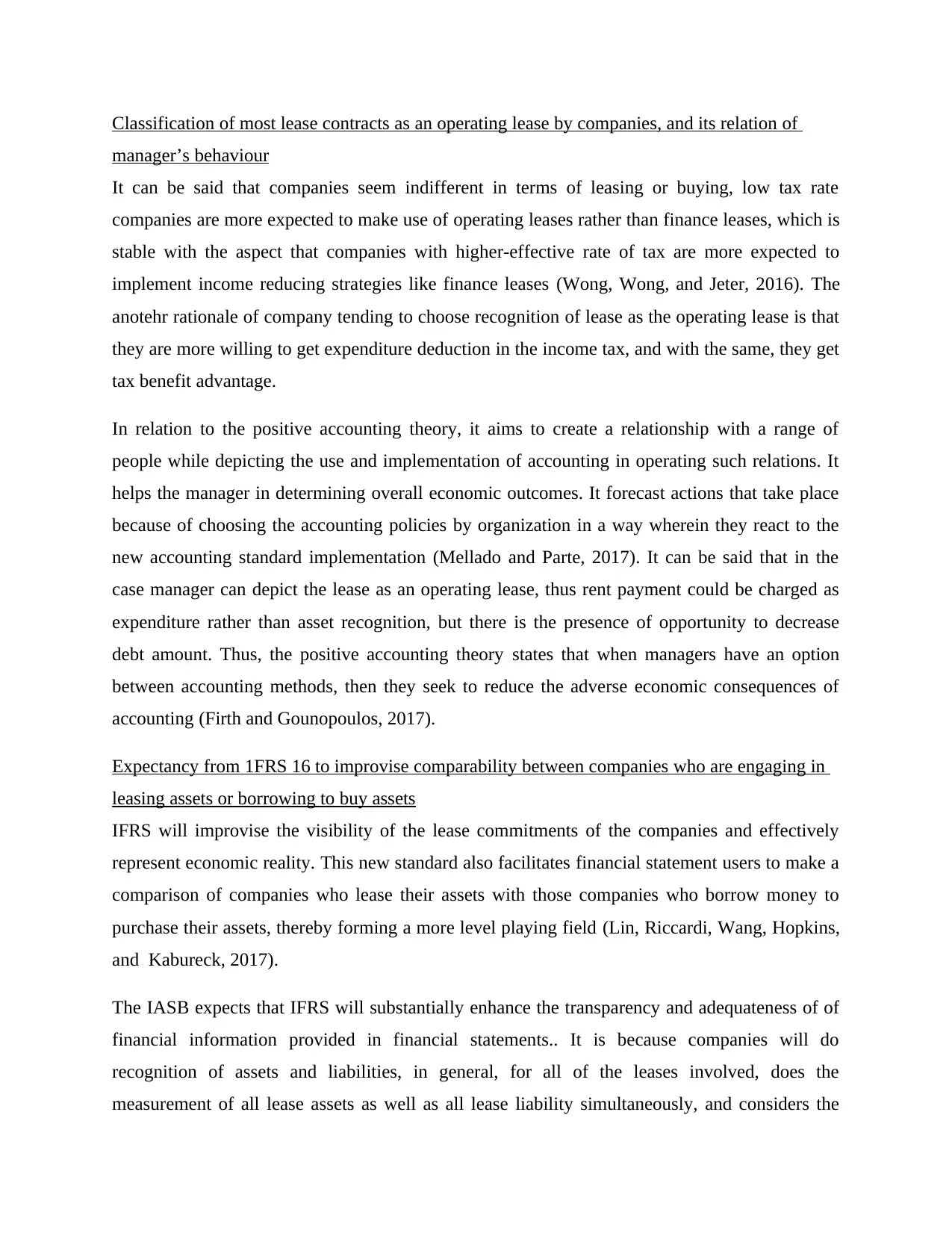
Classification of most lease contracts as an operating lease by companies, and its relation of
manager’s behaviour
It can be said that companies seem indifferent in terms of leasing or buying, low tax rate
companies are more expected to make use of operating leases rather than finance leases, which is
stable with the aspect that companies with higher-effective rate of tax are more expected to
implement income reducing strategies like finance leases (Wong, Wong, and Jeter, 2016). The
anotehr rationale of company tending to choose recognition of lease as the operating lease is that
they are more willing to get expenditure deduction in the income tax, and with the same, they get
tax benefit advantage.
In relation to the positive accounting theory, it aims to create a relationship with a range of
people while depicting the use and implementation of accounting in operating such relations. It
helps the manager in determining overall economic outcomes. It forecast actions that take place
because of choosing the accounting policies by organization in a way wherein they react to the
new accounting standard implementation (Mellado and Parte, 2017). It can be said that in the
case manager can depict the lease as an operating lease, thus rent payment could be charged as
expenditure rather than asset recognition, but there is the presence of opportunity to decrease
debt amount. Thus, the positive accounting theory states that when managers have an option
between accounting methods, then they seek to reduce the adverse economic consequences of
accounting (Firth and Gounopoulos, 2017).
Expectancy from 1FRS 16 to improvise comparability between companies who are engaging in
leasing assets or borrowing to buy assets
IFRS will improvise the visibility of the lease commitments of the companies and effectively
represent economic reality. This new standard also facilitates financial statement users to make a
comparison of companies who lease their assets with those companies who borrow money to
purchase their assets, thereby forming a more level playing field (Lin, Riccardi, Wang, Hopkins,
and Kabureck, 2017).
The IASB expects that IFRS will substantially enhance the transparency and adequateness of of
financial information provided in financial statements.. It is because companies will do
recognition of assets and liabilities, in general, for all of the leases involved, does the
measurement of all lease assets as well as all lease liability simultaneously, and considers the
manager’s behaviour
It can be said that companies seem indifferent in terms of leasing or buying, low tax rate
companies are more expected to make use of operating leases rather than finance leases, which is
stable with the aspect that companies with higher-effective rate of tax are more expected to
implement income reducing strategies like finance leases (Wong, Wong, and Jeter, 2016). The
anotehr rationale of company tending to choose recognition of lease as the operating lease is that
they are more willing to get expenditure deduction in the income tax, and with the same, they get
tax benefit advantage.
In relation to the positive accounting theory, it aims to create a relationship with a range of
people while depicting the use and implementation of accounting in operating such relations. It
helps the manager in determining overall economic outcomes. It forecast actions that take place
because of choosing the accounting policies by organization in a way wherein they react to the
new accounting standard implementation (Mellado and Parte, 2017). It can be said that in the
case manager can depict the lease as an operating lease, thus rent payment could be charged as
expenditure rather than asset recognition, but there is the presence of opportunity to decrease
debt amount. Thus, the positive accounting theory states that when managers have an option
between accounting methods, then they seek to reduce the adverse economic consequences of
accounting (Firth and Gounopoulos, 2017).
Expectancy from 1FRS 16 to improvise comparability between companies who are engaging in
leasing assets or borrowing to buy assets
IFRS will improvise the visibility of the lease commitments of the companies and effectively
represent economic reality. This new standard also facilitates financial statement users to make a
comparison of companies who lease their assets with those companies who borrow money to
purchase their assets, thereby forming a more level playing field (Lin, Riccardi, Wang, Hopkins,
and Kabureck, 2017).
The IASB expects that IFRS will substantially enhance the transparency and adequateness of of
financial information provided in financial statements.. It is because companies will do
recognition of assets and liabilities, in general, for all of the leases involved, does the
measurement of all lease assets as well as all lease liability simultaneously, and considers the
⊘ This is a preview!⊘
Do you want full access?
Subscribe today to unlock all pages.

Trusted by 1+ million students worldwide
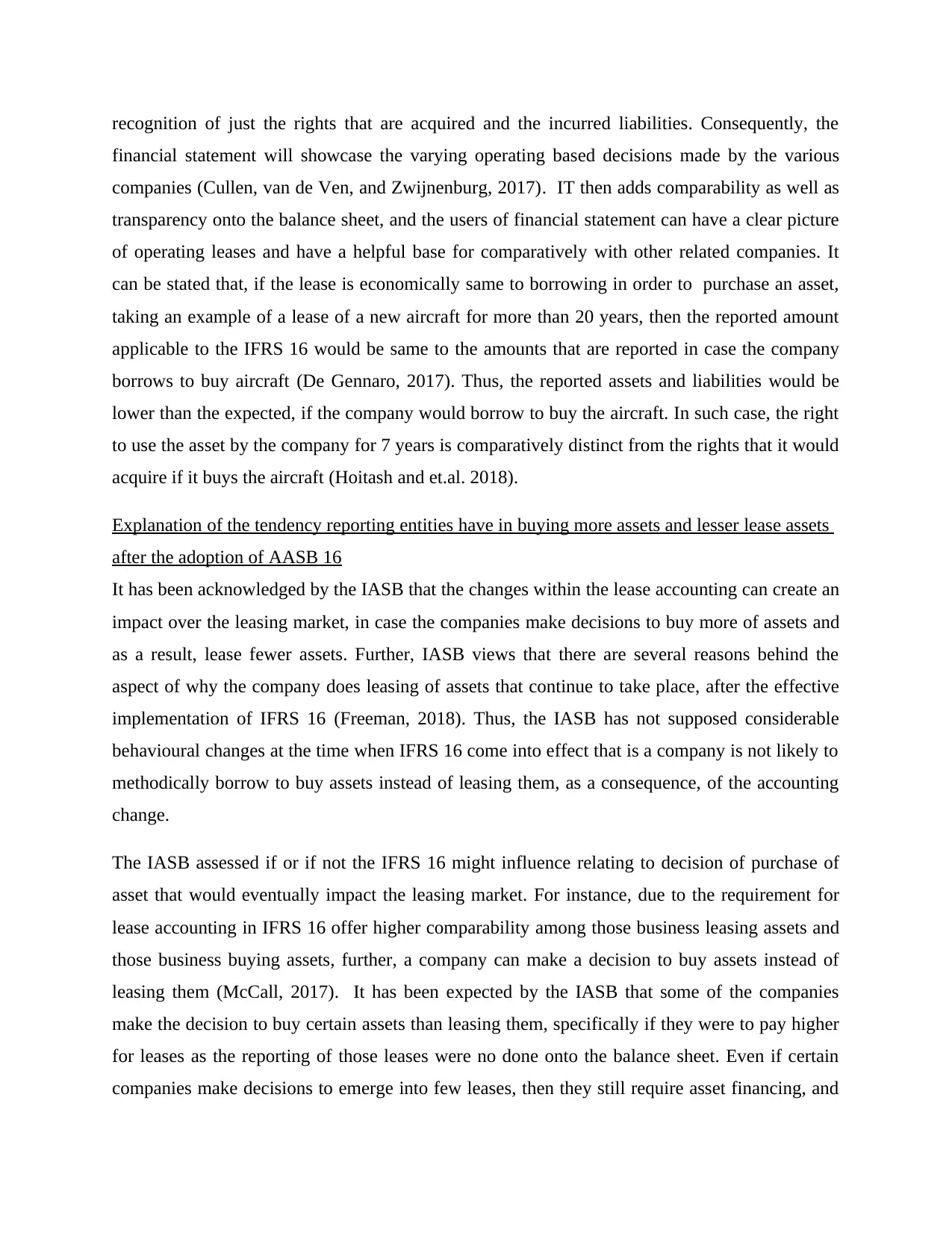
recognition of just the rights that are acquired and the incurred liabilities. Consequently, the
financial statement will showcase the varying operating based decisions made by the various
companies (Cullen, van de Ven, and Zwijnenburg, 2017). IT then adds comparability as well as
transparency onto the balance sheet, and the users of financial statement can have a clear picture
of operating leases and have a helpful base for comparatively with other related companies. It
can be stated that, if the lease is economically same to borrowing in order to purchase an asset,
taking an example of a lease of a new aircraft for more than 20 years, then the reported amount
applicable to the IFRS 16 would be same to the amounts that are reported in case the company
borrows to buy aircraft (De Gennaro, 2017). Thus, the reported assets and liabilities would be
lower than the expected, if the company would borrow to buy the aircraft. In such case, the right
to use the asset by the company for 7 years is comparatively distinct from the rights that it would
acquire if it buys the aircraft (Hoitash and et.al. 2018).
Explanation of the tendency reporting entities have in buying more assets and lesser lease assets
after the adoption of AASB 16
It has been acknowledged by the IASB that the changes within the lease accounting can create an
impact over the leasing market, in case the companies make decisions to buy more of assets and
as a result, lease fewer assets. Further, IASB views that there are several reasons behind the
aspect of why the company does leasing of assets that continue to take place, after the effective
implementation of IFRS 16 (Freeman, 2018). Thus, the IASB has not supposed considerable
behavioural changes at the time when IFRS 16 come into effect that is a company is not likely to
methodically borrow to buy assets instead of leasing them, as a consequence, of the accounting
change.
The IASB assessed if or if not the IFRS 16 might influence relating to decision of purchase of
asset that would eventually impact the leasing market. For instance, due to the requirement for
lease accounting in IFRS 16 offer higher comparability among those business leasing assets and
those business buying assets, further, a company can make a decision to buy assets instead of
leasing them (McCall, 2017). It has been expected by the IASB that some of the companies
make the decision to buy certain assets than leasing them, specifically if they were to pay higher
for leases as the reporting of those leases were no done onto the balance sheet. Even if certain
companies make decisions to emerge into few leases, then they still require asset financing, and
financial statement will showcase the varying operating based decisions made by the various
companies (Cullen, van de Ven, and Zwijnenburg, 2017). IT then adds comparability as well as
transparency onto the balance sheet, and the users of financial statement can have a clear picture
of operating leases and have a helpful base for comparatively with other related companies. It
can be stated that, if the lease is economically same to borrowing in order to purchase an asset,
taking an example of a lease of a new aircraft for more than 20 years, then the reported amount
applicable to the IFRS 16 would be same to the amounts that are reported in case the company
borrows to buy aircraft (De Gennaro, 2017). Thus, the reported assets and liabilities would be
lower than the expected, if the company would borrow to buy the aircraft. In such case, the right
to use the asset by the company for 7 years is comparatively distinct from the rights that it would
acquire if it buys the aircraft (Hoitash and et.al. 2018).
Explanation of the tendency reporting entities have in buying more assets and lesser lease assets
after the adoption of AASB 16
It has been acknowledged by the IASB that the changes within the lease accounting can create an
impact over the leasing market, in case the companies make decisions to buy more of assets and
as a result, lease fewer assets. Further, IASB views that there are several reasons behind the
aspect of why the company does leasing of assets that continue to take place, after the effective
implementation of IFRS 16 (Freeman, 2018). Thus, the IASB has not supposed considerable
behavioural changes at the time when IFRS 16 come into effect that is a company is not likely to
methodically borrow to buy assets instead of leasing them, as a consequence, of the accounting
change.
The IASB assessed if or if not the IFRS 16 might influence relating to decision of purchase of
asset that would eventually impact the leasing market. For instance, due to the requirement for
lease accounting in IFRS 16 offer higher comparability among those business leasing assets and
those business buying assets, further, a company can make a decision to buy assets instead of
leasing them (McCall, 2017). It has been expected by the IASB that some of the companies
make the decision to buy certain assets than leasing them, specifically if they were to pay higher
for leases as the reporting of those leases were no done onto the balance sheet. Even if certain
companies make decisions to emerge into few leases, then they still require asset financing, and
Paraphrase This Document
Need a fresh take? Get an instant paraphrase of this document with our AI Paraphraser
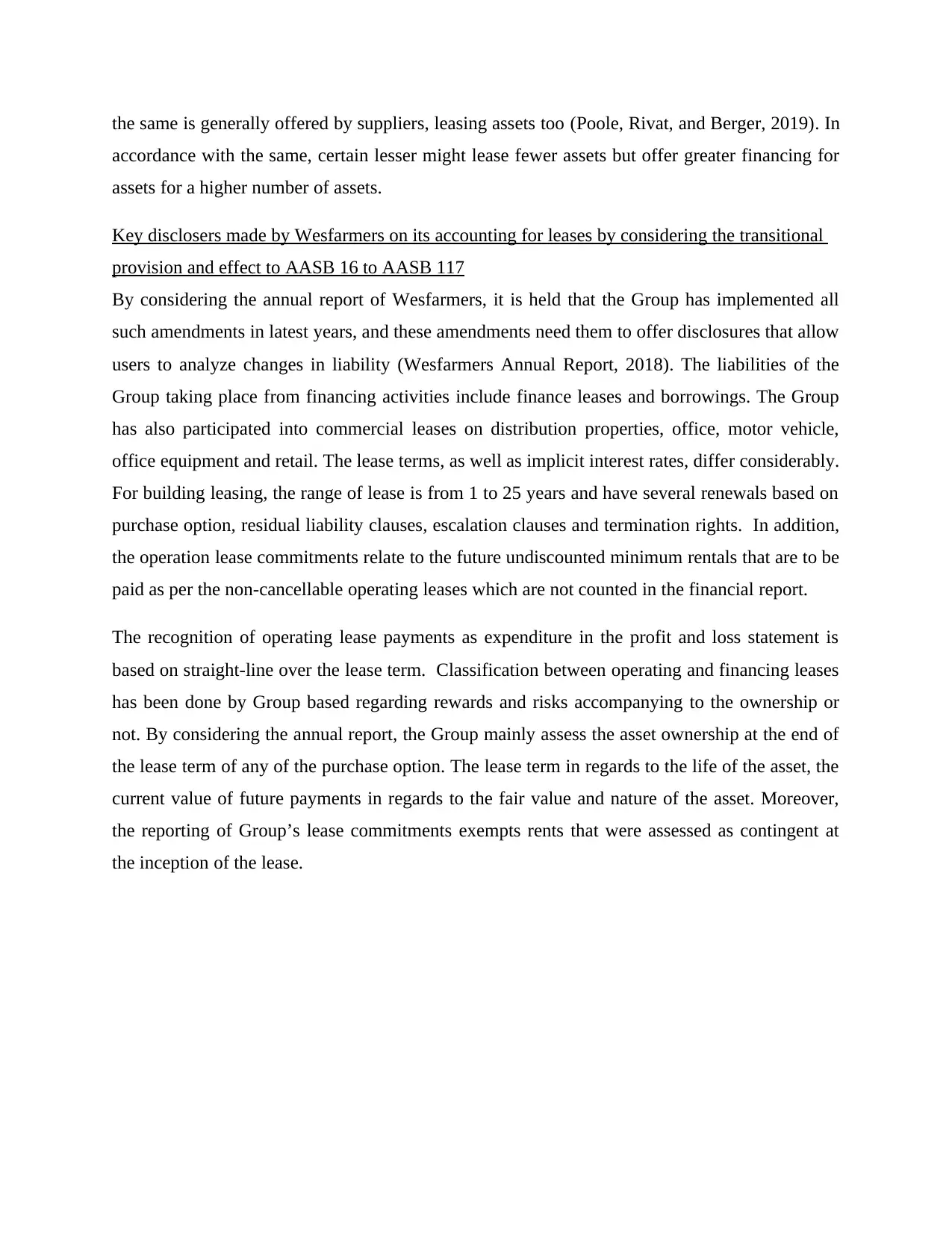
the same is generally offered by suppliers, leasing assets too (Poole, Rivat, and Berger, 2019). In
accordance with the same, certain lesser might lease fewer assets but offer greater financing for
assets for a higher number of assets.
Key disclosers made by Wesfarmers on its accounting for leases by considering the transitional
provision and effect to AASB 16 to AASB 117
By considering the annual report of Wesfarmers, it is held that the Group has implemented all
such amendments in latest years, and these amendments need them to offer disclosures that allow
users to analyze changes in liability (Wesfarmers Annual Report, 2018). The liabilities of the
Group taking place from financing activities include finance leases and borrowings. The Group
has also participated into commercial leases on distribution properties, office, motor vehicle,
office equipment and retail. The lease terms, as well as implicit interest rates, differ considerably.
For building leasing, the range of lease is from 1 to 25 years and have several renewals based on
purchase option, residual liability clauses, escalation clauses and termination rights. In addition,
the operation lease commitments relate to the future undiscounted minimum rentals that are to be
paid as per the non-cancellable operating leases which are not counted in the financial report.
The recognition of operating lease payments as expenditure in the profit and loss statement is
based on straight-line over the lease term. Classification between operating and financing leases
has been done by Group based regarding rewards and risks accompanying to the ownership or
not. By considering the annual report, the Group mainly assess the asset ownership at the end of
the lease term of any of the purchase option. The lease term in regards to the life of the asset, the
current value of future payments in regards to the fair value and nature of the asset. Moreover,
the reporting of Group’s lease commitments exempts rents that were assessed as contingent at
the inception of the lease.
accordance with the same, certain lesser might lease fewer assets but offer greater financing for
assets for a higher number of assets.
Key disclosers made by Wesfarmers on its accounting for leases by considering the transitional
provision and effect to AASB 16 to AASB 117
By considering the annual report of Wesfarmers, it is held that the Group has implemented all
such amendments in latest years, and these amendments need them to offer disclosures that allow
users to analyze changes in liability (Wesfarmers Annual Report, 2018). The liabilities of the
Group taking place from financing activities include finance leases and borrowings. The Group
has also participated into commercial leases on distribution properties, office, motor vehicle,
office equipment and retail. The lease terms, as well as implicit interest rates, differ considerably.
For building leasing, the range of lease is from 1 to 25 years and have several renewals based on
purchase option, residual liability clauses, escalation clauses and termination rights. In addition,
the operation lease commitments relate to the future undiscounted minimum rentals that are to be
paid as per the non-cancellable operating leases which are not counted in the financial report.
The recognition of operating lease payments as expenditure in the profit and loss statement is
based on straight-line over the lease term. Classification between operating and financing leases
has been done by Group based regarding rewards and risks accompanying to the ownership or
not. By considering the annual report, the Group mainly assess the asset ownership at the end of
the lease term of any of the purchase option. The lease term in regards to the life of the asset, the
current value of future payments in regards to the fair value and nature of the asset. Moreover,
the reporting of Group’s lease commitments exempts rents that were assessed as contingent at
the inception of the lease.
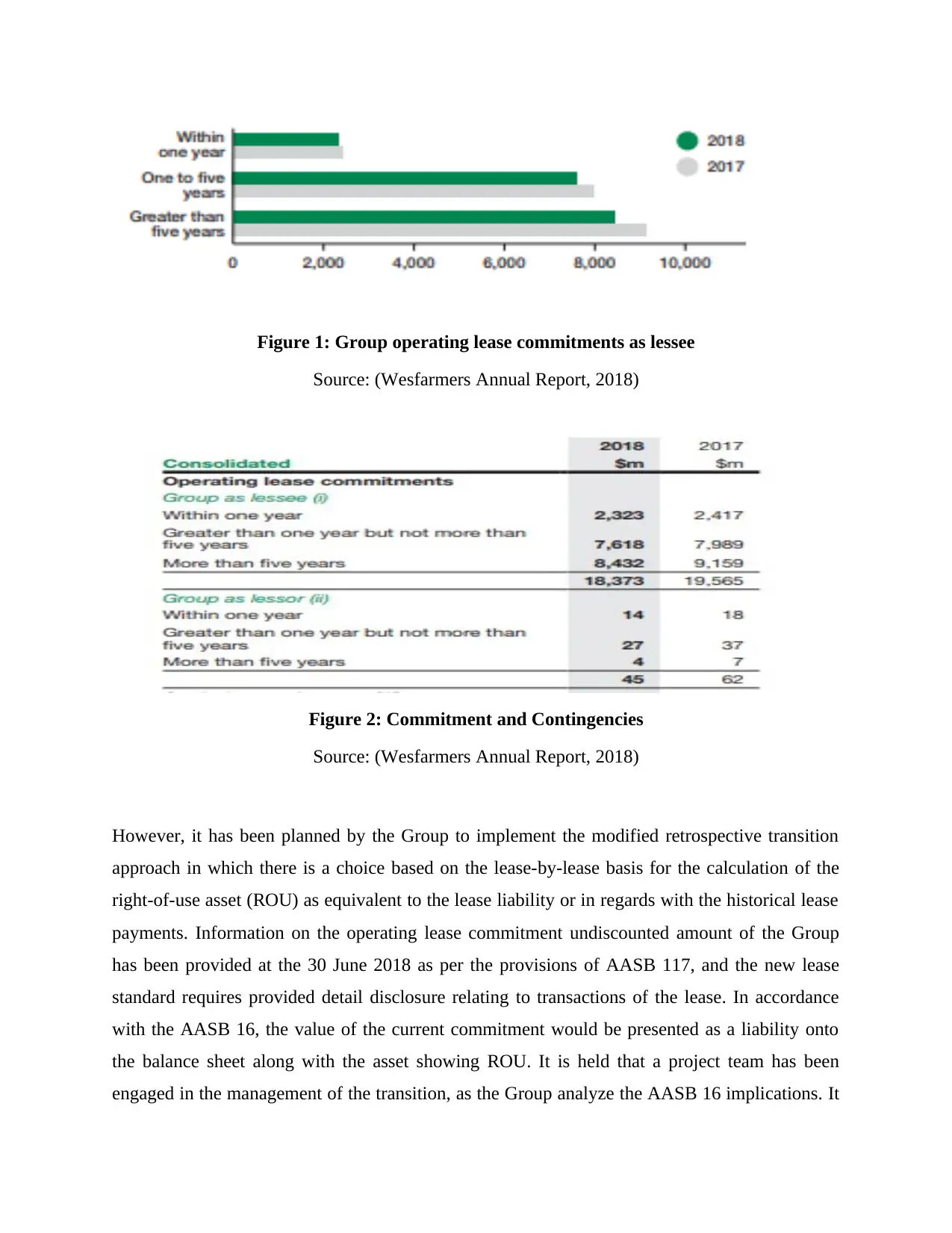
Figure 1: Group operating lease commitments as lessee
Source: (Wesfarmers Annual Report, 2018)
Figure 2: Commitment and Contingencies
Source: (Wesfarmers Annual Report, 2018)
However, it has been planned by the Group to implement the modified retrospective transition
approach in which there is a choice based on the lease-by-lease basis for the calculation of the
right-of-use asset (ROU) as equivalent to the lease liability or in regards with the historical lease
payments. Information on the operating lease commitment undiscounted amount of the Group
has been provided at the 30 June 2018 as per the provisions of AASB 117, and the new lease
standard requires provided detail disclosure relating to transactions of the lease. In accordance
with the AASB 16, the value of the current commitment would be presented as a liability onto
the balance sheet along with the asset showing ROU. It is held that a project team has been
engaged in the management of the transition, as the Group analyze the AASB 16 implications. It
Source: (Wesfarmers Annual Report, 2018)
Figure 2: Commitment and Contingencies
Source: (Wesfarmers Annual Report, 2018)
However, it has been planned by the Group to implement the modified retrospective transition
approach in which there is a choice based on the lease-by-lease basis for the calculation of the
right-of-use asset (ROU) as equivalent to the lease liability or in regards with the historical lease
payments. Information on the operating lease commitment undiscounted amount of the Group
has been provided at the 30 June 2018 as per the provisions of AASB 117, and the new lease
standard requires provided detail disclosure relating to transactions of the lease. In accordance
with the AASB 16, the value of the current commitment would be presented as a liability onto
the balance sheet along with the asset showing ROU. It is held that a project team has been
engaged in the management of the transition, as the Group analyze the AASB 16 implications. It
⊘ This is a preview!⊘
Do you want full access?
Subscribe today to unlock all pages.

Trusted by 1+ million students worldwide
1 out of 17
Related Documents
Your All-in-One AI-Powered Toolkit for Academic Success.
+13062052269
info@desklib.com
Available 24*7 on WhatsApp / Email
![[object Object]](/_next/static/media/star-bottom.7253800d.svg)
Unlock your academic potential
Copyright © 2020–2025 A2Z Services. All Rights Reserved. Developed and managed by ZUCOL.




